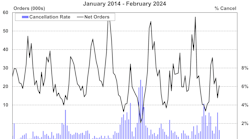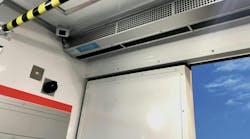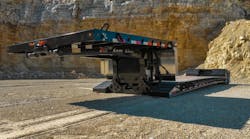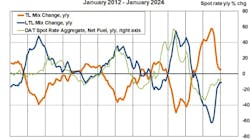Demand for commercial trucks and trailers is expected to stay strong well into next year, according to a variety of reports, though the growing shortage of drivers may be curbing the purchasing plans of many fleets.
According to a new IHS Automotive analysis, commercial vehicle market demand in the U.S. is expected to stay strong for the next 15 months, with the firm identifying over 500,000 businesses operating fleets ranging from one to 250 vehicles, and representing over 2.5 million units, that are expected to buy another new vehicle during that time period – data derived through the firm’s new Return-To-Market (RTM) Commercial Vehicle Predictor.
The quarterly Fleet Sentiment survey conducted in early October by CK Commercial Vehicle Research (CKCVR) indicates that fleet equipment ordering activity could be similar in 2016 to what it has been for 2015.
Chris Kemmer, head of CKCVR, noted that a majority (76%) expect their heavy duty truck orders to match what was purchased in 2015 – with a few more even planning an increase – while a smaller percent (63%) said the same about their trailer orders.
Yet the driver shortage “continues to plague most fleets” Kemmer noted, especially in terms of retarding their ability to grow to take advantage of good freight demand.
“Many are simply not adding to their fleet because they don’t have enough drivers to fill current seats let alone additional seats,” she explained.
Kemmer also stressed that equipment demand in 2016 can change if the economy falters. “While a majority of the fleets reporting to us saw their business as good or even excellent, any fall off in freight or work demand will certainly cause them to re-think their 2016 plans,” she emphasized.
Fleets surveyed by CKCVR have “upgraded their equipment at a pretty high level over the last two to three years,” Kenner said, and thus she expects they could “take a pause” in new equipment purchases without taking a significant hit to maintenance costs associated with older vehicles.
“But if the economy stays fairly strong, they will likely continue to purchase new trucks and trailers at a similar level as we’ve seen this year,” Kemmer noted.
Several truck manufacturers echoed Kemmer’s perspective in recent commentary.
“The U.S. and Canada truck industry Class 8 retail sales year-to-date are 18% higher compared to the same period last year, [with] Kenworth and Peterbilt customers benefiting from good economic growth, strong freight tonnage and lower fuel prices,” noted Dan Sobic, executive VP on Paccar Corp., in the company’s third quarter earnings report last week.
He added that Paccar estimates Class 8 industry retail sales for the U.S. and Canada in 2015 to range between 275,000 and 285,000 units this year
“Next year should be another strong year for truck sales,” Sobic noted, with Paccar estimating U.S. and Canada truck industry Class 8 retail sales to range between 240,000 and 270,000 units in 2016.
Stephen Roy, president of Mack Trucks North America, also expressed optimism regarding truck sales in 2016 in an interview several weeks ago.
“I think we’ll have a good year [in 2016]; we don’t see a real big dip occurring in sales next year,” Roy told Fleet Owner. “Replacement demand is still driving a lot of sales but we’re also seeing the new companies entering the market, too; there’s a lot of acquisition activity going on in trucking right now.”
Yet, like CKCVR’s Kemmer noted, the major factor limiting truck sales right now and for the foreseeable future remains the ongoing – and increasing – shortage of drivers, he stressed.
“Absolutely we could sell more trucks if there were simply more drivers,” he said. “That shortage continues to be the limiting factor [for sales].”








